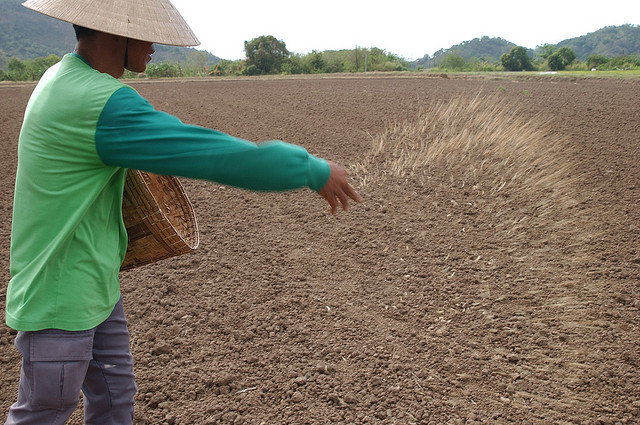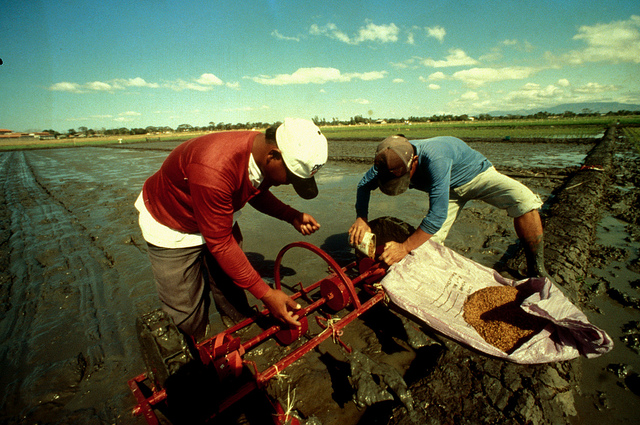Direct seeding
Direct seeded crops require less labor and tend to mature faster than transplanted crops.
In this method, plants are not subjected to stresses such as being pulled from the soil and re-establishing fine rootlets. However, they have more competition from weeds.
Depending on the land preparation method used, direct seeding can be done in two ways:
Dry direct seeding
This method is usually practiced for rainfed and deepwater ecosystems. Farmers sow onto dry soil surface, then incorporates the seed either by plowing or harrowing.
- Broadcasting

- Broadcast 60−80 kg of seeds uniformly by hand or in furrows in 1 ha of field.
- Make shallow furrows by passing a furrower along the prepared field.
- After broadcasting, cover the seeds using a spike-tooth harrow.
- Drilling
Precision equipment, such as the Turbo Happy Seeder, can be used to drill seeds.
Drill 80−100 kg of seeds per ha.
Seeds are placed by the machine into both dry and moist soil, and then irrigated. A smooth, level seedbed is necessary to ensure that seeds are not planted at depths greater than 10−15 mm.
In this technique, fertilizers can be applied at the same time as the seed. Manual weeding also is easier in machine-drilled crops than in broadcast crops.
- Dibbling
Dibbling or hill planting is usually practiced along mountain slopes or where plowing and harrowing are difficult.
- Use a long wood or bamboo pole with a metal scoop attached at the end for digging holes.
- Drop the seeds into the holes and cover them with soil.
Wet direct seeding
In wet fields, direct seeding can be done either through broadcasting or drilling seeds into the mud with a drum seeder.
- Broadcasting
Broadcast 80−100 kg per ha of pre-germinated seeds to recently drained, well-puddled seedbeds or into shallow standing water.
If water in the field is muddy, allow 1−2 days for it to dry before broadcasting.
If water is drained from the fields after broadcasting, seeds are re-introduced 10−15 days after first seeding.
 Drum seeding
Drum seeding
Drum seeders are used for fast planting. It operates best on a well-leveled, smooth, and wet seedbed. However, seeders may be clogged if the soil is sticky or if the machine is poorly designed.
Prepare 80 kg of pre-germinated seeds per ha.
Direct seeded rice have more competition from weeds. Weeds can be controlled through the following:
 Stale seedbed technique
Stale seedbed technique
This technique is best if the field has a large weed seed bank.
It can greatly reduce the weeds in DSR because of the 2–month fallow period between harvest and sowing, which allows weeds to emerge before they are killed.
This technique is also helpful in managing weedy rice.
Read: How to do stale seedbed technique
 Use of herbicides
Use of herbicides
The choice of herbicide depends on the type of weeds. No single herbicide can control all weeds in the rice crop.
For effective weed control, apply a pre-emergence herbicide, 1–3 DAS. While post-emergence application should be at 15–25 DAS.
Read: How to use herbicides to effectively control weeds
 Weeding by hand or by machine
Weeding by hand or by machine
Weeds are practically impossible to control by manual weeding by hand. However, one or two spot hand weeding can be done to (1) remove weeds that escape herbicide application, (2) prevent weed seed production and the accumulation of weed seeds in the soil.
In mechanical weeding, motorized cono and other hand weeders can be used.